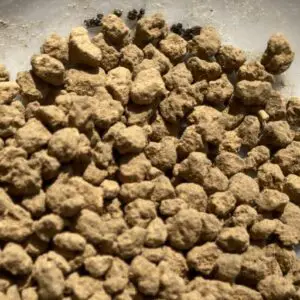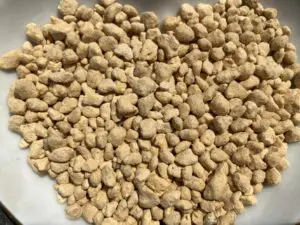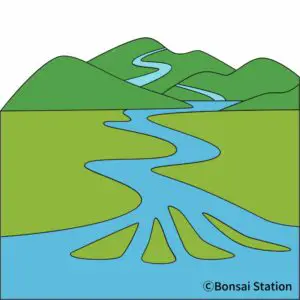There are many types of gardening soil but not all of them are suitable for bonsai soil mix. Bonsai soil requires good aeration, drainage and water retention as well as good nutrient holding capacity.
As a general rule, types of soil best suited as bonsai soil are Akadama, Kanuma soil, volcanic soil/ lava rock, river sand, pumice, perlite, vermiculite and organic compost.
Types of bonsai soil: Comparison table
| Aeration | Drainage | Water holding Capacity |
Nutrient holding Capacity |
pH | |
| Akadama | High | High | High | High | pH 5.1-5.5 |
| Kanuma | High | High | High | High | pH 5.0-5.5 |
| Volcanic soil / lava rock | High | High | Mid-Low | High | pH 6.0-7.0 |
| River sand | High | High | Mid-Low | Low | pH 6.0-7.0 |
| Pumice | High | High | Low | Low | pH 5.5-6.5 |
| Perlite | High | High | Mid | Low | pH 7.5-8.5 |
| Vermiculite | High | High | High | Mid-High | pH 6.0-7.0 |
| Organic compost | High | High | High | High | pH 6.0-7.0 |
Types of bonsai soil
Akadama

Akadama
| Aeration | Drainage | Water holding Capacity |
Nutrient holding Capacity |
pH | |
| Akadama | High | High | High | High | pH 5.1-5.5 |
Akadama is volcanic ash found in the northern Tokyo area. It is found naturally in a grain-like shape, with a size of 0.1-0.4 inches on average. Akadama has numerous pores through which fine bonsai roots can grow.
For more detail about Akadama, please refer to the following post.
Kanuma soil

Kanuma
| Aeration | Drainage | Water holding Capacity |
Nutrient holding Capacity |
pH | |
| Kanuma | High | High | High | High | pH 5.0-5.5 |
Kanuma soil is a granular clay-like mineral, which is a weathered volcanic pumice stone. Kanuma soil is pale yellow in color when it is dry with a size of 0.1-0.4 inches on average. The name “Kanuma” comes from the name of the city, Kanuma, 90 miles north of Tokyo, where Kanuma soil is mainly mined.
For more detail about Kanuma soil, please refer to the following post.
Volcanic soil / lava rock

Volcanic soil
| Aeration | Drainage | Water holding Capacity |
Nutrient holding Capacity |
pH | |
| Volcanic sand/ lava rock | High | High | Mid-low | Mid-low | pH 6.0-7.0 |
Volcanic soil = lava rock is formed from lava erupted from a volcano. Due to its porosity, volcanic soil has good aeration and drainage. Its water-holding and nutrient-holding capacities depend on where it came from; both can be medium or low but not high.
For more detail about volcanic soil, please refer to the following post.
River sand

| Aeration | Drainage | Water holding Capacity |
Nutrient holding Capacity |
pH | |
| River sand | High | High | Mid-Low | Low | pH 6.0-7.0 |
River sand is the type of sand collected from the river bed that is made from weathering or erosion processes.
River sand can be used for bonsai if the sand is volcanic such as granite, and is collected upstream in a sharp and angular form.
For more detail about river sand, please refer to the following post.
Pumice
| Aeration | Drainage | Water holding Capacity |
Nutrient holding Capacity |
pH | |
| Pumice | High | High | Low | Low | pH 5.5-6.5 |
Pumice is porous, lightweight and usually light-colored. It is a volcanic rock created when a gas-rich, super-heated, highly pressurized rock is ejected from a volcano, solidifying rapidly.
Is pumice good for bonsai?
Pumice is commonly used as bonsai soil and can be used for most of the bonsai tree species. In fact, Kanuma soil is a kind of pumice that is used particularly for azalea bonsai. Pumice can also be used at the bottom of pots for drainage.
Although pumice has good drainage and aeration ability, its water-holding and nutrient-holding capacity is low, which is a major drawback as bonsai soil.
Perlite
| Aeration | Drainage | Water holding Capacity |
Nutrient holding Capacity |
pH | |
| Perlite | High | High | Mid | Low | pH 7.5-8.5 |
Perlite is a volcanic glass. It is porous, light and white in color, formed by rapid heating.
When obsidian (a black volcanic glass) is heated to 1600 degrees F (850 degrees C), water trapped in the structure vaporizes and escapes and the rock expands 7–16 times its original volume. The expanded material becomes white because the trapped bubbles reflect light. This process occurs naturally but perlite can be manufactured.
Is perlite good for bonsai soil?
Perlite is not ideal for bonsai soil because it is alkaline. Most of the bonsai tree species, as other plants, prefer acidic soil, not alkaline. Also, perlite is very lightweight and can easily flow out of the bonsai pot with watering, as the soil is usually as high as the rim of the pot.
On the other hand, perlite can be used for the germination of bonsai tree seeds and for growing bonsai trees from cuttings.
Vermiculite
| Aeration | Drainage | Water holding Capacity |
Nutrient holding Capacity |
pH | |
| Vermiculite | High | High | High | Mid-High | pH 6.0-7.0 |
Vermiculite used as bonsai soil is a lightweight silicate mineral that is expanded by heating. It is in the form of shiny flakes, which are usually golden brown to blackish in color. It can hold on to nutrients added as fertilizers very well.
Is vermiculite good for bonsai soil?
Vermiculite could be used as bonsai soil. It has high drainage, aeration and water-holding capacity as well as medium to high nutrient holding capacity, which are the qualities desirable for bonsai soil. Vermiculite can also be used for the germination of bonsai tree seeds and for growing bonsai trees from cuttings.
One major drawback of vermiculite as bonsai soil is its looks; vermiculite is a shiny golden flake and does not match the bonsai aesthetics, which embraces simple and natural Zen beauty.
Organic compost
| Aeration | Drainage | Water holding Capacity |
Nutrient holding Capacity |
pH | |
| Organic compost | High | High | High | High | pH 6.0-7.0 |
Organic potting compost, like humus, is a dark, soft and light-weighted organic matter formed by the decomposition of animals or/and plants. It is rich in nutrients and retains moisture while having adequate drainage.
Bonsai soil should not contain a high percentage of organic matter.
For more details about the usage of organic compost in bonsai soil, please refer to the following post.



